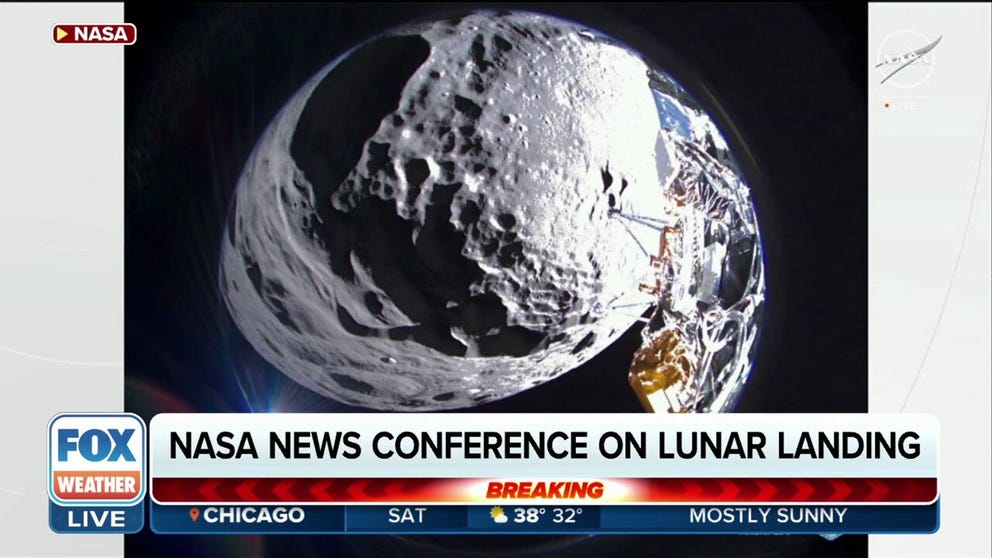Odysseus Moon lander continues to send back photos showing unexplored region near lunar South Pole
Photos from NASA's LRO spacecraft show the Moon lander's position near the lunar South Pole. Intuitive Machines flight controllers are working to determine lander's battery life once lunar night sets.
NASA, Intuitive Machines provide update on Moon lander
Officials from NASA and Intuitive Machines gave an update on the status of the Odysseus lander that touched down on the Moon on Thursday.
Intuitive Machines and NASA shared more photos from the unexplored region near the Moon's South Pole from the newly arrived Moon lander sideways on the lunar surface.
After touching down near the lunar South Pole on Thursday, achieving the first private Moon landing, Intuitive Machines waited a handful of long minutes to confirm the spacecraft survived due to a communication loss. After waiting with bated breath, the signal was detected from the Goonhilly Earth Station radio telescope in Cornwall, United Kingdom.
ODYSSEUS ON THE MOON: INTUITIVE MACHINES RECEIVES PHOTO OF LANDER NEAR LUNAR SOUTH POLE
About 24 hours after the landing, Intuitive Machines and NASA released one photo taken during the landing sequence. It showed part of the spacecraft and the Schomberger Crater on the Moon. The company said the image was taken about 6 miles above the Moon.

The last known photo taken by the Odysseus spacecraft prior to landing on the Moon on Feb. 22, 2024. It was taken about 6 miles above the surface and shows Schomberger Crater, about 120 miles away from the crafts landing site.
(Intuitive Machines / NASA)
INTUITIVE MACHINES RETURNS AMERICA TO MOON’S SURFACE FOR FIRST TIME SINCE 1972
However, it took longer for more photos to be released, partially because the team had to improvise when the spacecraft's navigational laser failed. It's also important to note that, unlike the Apollo missions, this is a private mission with NASA payloads onboard. NASA paid Intuitive Machines $118 million to shuttle six payloads to the lunar South Pole as part of its Commercial Lunar Payload Services (CLPS) program.
This week, Intuitive Machines released more images taken by the lander during its arrival at the Moon.
"After understanding the end-to-end communication requirements, Odysseus sent images from the lunar surface of its vertical descent to its Malapert A landing site, representing the furthest south any vehicle has been able to land on the Moon and establish communication with ground controllers," Intuitive Machines said in a statement.
On Tuesday, the company shared photos taken by the spacecraft about 30 meters (98 feet) from the Moon as it came in for landing.
"Odysseus is quite the photographer, capturing this image approximately 30 meters above the lunar surface while his main engine throttled down more than 24,000 mph," Intuitive Machines said.
Intuitive Machines CEO Steve Altemus said during a news conference on Friday that they think the lander tipped over onto a Moon rock. Engineers believe this because fuel tank readings indicate the lander is on its side.
One of the new images released above shows the sideways perspective of the lander.
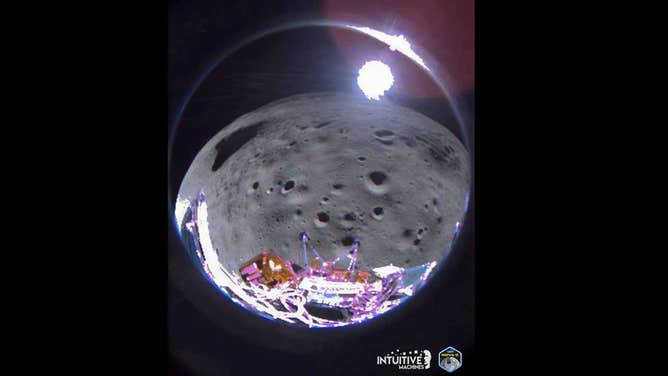
A photo taken by the Odysseus lander approximately 35 seconds after pitching over during its approach to the landing site. (Image: Intuitive Machines)
"Odysseus captured this image approximately 35 seconds after pitching over during its approach to the landing site," Intuitive Machines said. "The camera is on the starboard aft-side of the lander in this phase."
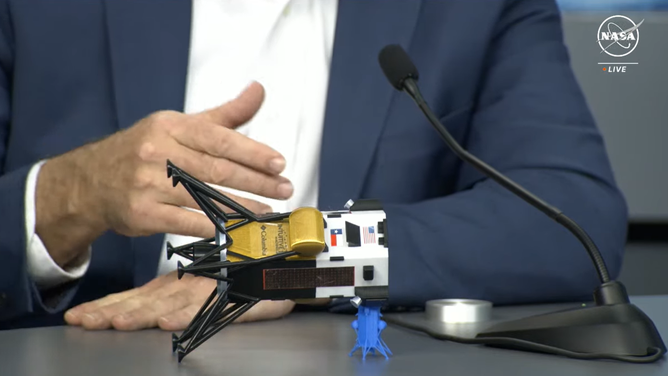
The Odysseus Moon lander orientation.
(NASA)
Intuitive Machines is now receiving data from the surface of the Moon, and the company continues to communicate with the lander.
As for Odysseus's position on the Moon, NASA's Lunar Reconnaissance Orbiter (LRO) flew over the landing site area over the weekend and was able to pinpoint the landing location.
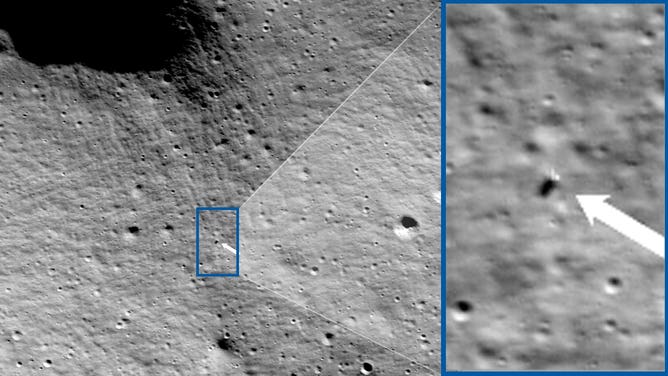
Images from NASA’s Lunar Reconnaissance Orbiter Camera show Odysseus completed its landing at 80.13°S and 1.44°E at a 2579 m elevation. (Image credit: NASA/Goddard/Arizona State University)
According to the images, the lander touched down less than 1 mile from its intended landing site near Malapert A.
LUNAR LANDER CAPTURES STUNNING PHOTOS OF EARTH BEFORE MOON LANDING ATTEMPT
Intuitive Machines said the lander's Hazard Relative Navigation algorithms detected nine safe landing sites within the South Pole region.
LRO confirmed a Japanese Aerospace Exploration Agency (JAXA) robotic Moon landing in January. JAXA's SLIM lander toppled over during its landing, coming down on its nose. Meanwhile, Intuitive Machines' mission is possibly sideways. Still, mission managers with both spacecraft say the landers achieved their primary goals. The Odysseus lander continues to power payloads on the Moon.
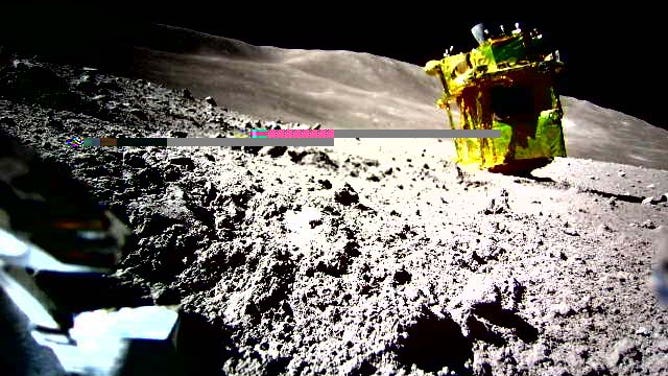
A photo from the probe Lev-2 shows the SLIM lander on its nose on the lunar surface.
(JAXA)
Even in 2024, Moon landings remain a major engineering challenge. Only about half of all Moon landing attempts dating back to the 1950s have been successful. Thursday's private Moon landing by Houston-based Intuitive Machines marked the first American landing since Apollo 17 in more than 50 years.
Intuitive Machines flight controllers expect to continue communication with Odysseus until its solar panels are no longer exposed to light. The lunar night is expected to arrive on Tuesday morning, possibly cutting off communication with the lander.
However, Intuitive Machines said flight controllers are working to determine the battery life of the lander, which may last up to an additional 20 hours.
More images from the Moon coming
There are more Moon images coming.
Thousands of photos were taken before the landing, according to Intuitive Machines Chief Technology Officer Tim Crain.
"We processed over 10,000 images on board with our own machine learning algorithms to manage the speed of the vehicle," Crain said of the spacecraft's autonomous navigation system.
During its descent phase, the spacecraft was designed to guide itself to the landing area known as Malapert using the Terrain Relative Navigation camera from Redwire Space. The high-definition camera looked for a safe landing spot free of craters, boulders and other hazards.
EagleCam, a camera from Embry-Riddle Aeronautical University (ERAU), was scheduled to deploy right before the landing. When complications with the navigation system arose, the university said the decision was made to power down the camera and not deploy the device during the final descent.
The camera was designed to photograph the lander's positioning during and after the landing.
On Saturday, the EagleCam team said it was working closely with Intuitive Machines to deploy the camera "as soon as possible." Simulations show that EagleCam could be deployed about 4.1 meters (13.5 feet) away from the lander.
"The goal is that the resulting images will provide critical insight into the lander's orientation, health and additional mission support," ERAU said.
